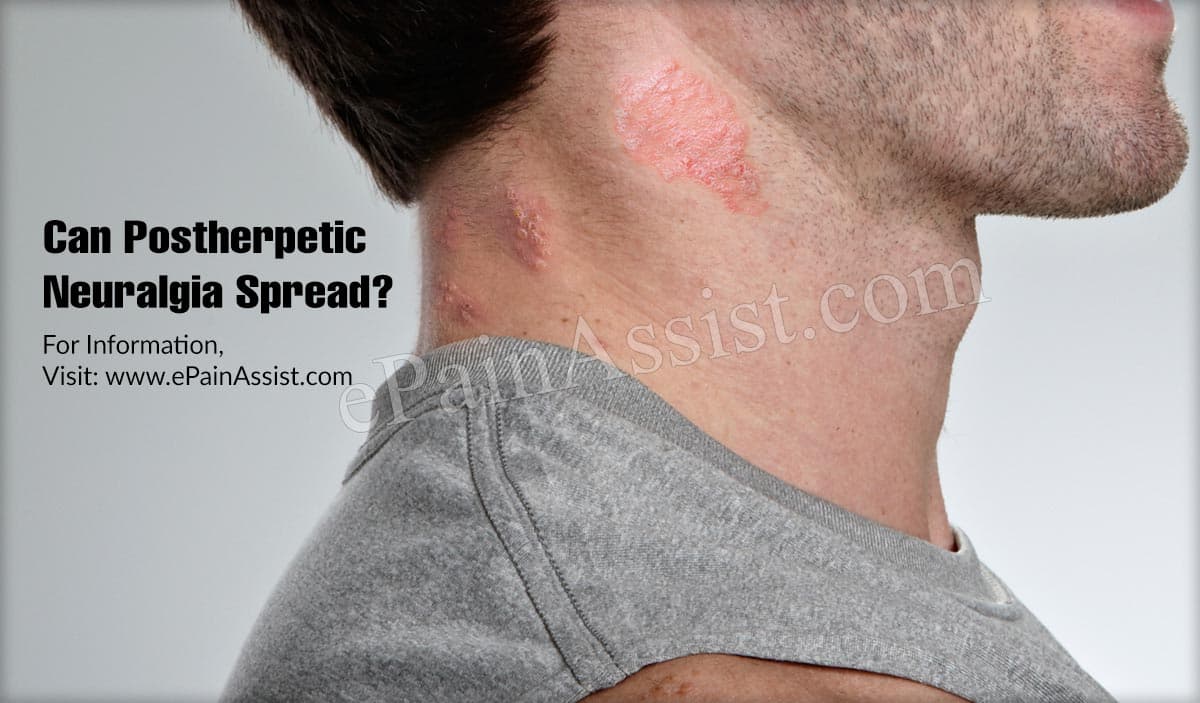Postherpetic neuralgia can spread from its remission site to other parts through sensory nerves. Spreading of neuralgia may be done though antiviral drugs, vaccines, and steroids.

Can Postherpetic Neuralgia Spread?
Postherpetic neuralgia is the condition caused due to herpes zoster virus infection. Postherpetic neuralgia is one of the most common complications of shingles infection. The disease has no cure and the remission of infection may occur as the virus is present in the body throughout life. Postherpetic neuralgia is caused because of the damage to the anatomical characteristic of the nerve by a virus. The nerve may become demyelinated and are highly sensitive to minimum mechanical stimulation leading to pain and inflammation. In its more serious form, postherpetic neuralgia may lead to paralysis or muscle weakness depending upon the severity of damage and type of nerve involved3.
The pain of postherpetic neuralgia is not located at one place and may radiate throughout, along with the neuronal pathways. Reactivation of virus from its dormant form results in is replication. These replicated viruses move down from their original place, trigeminal or dorsal root ganglia, through sensory nerves to skin or mucosa. This results in eruptions of unilateral vesicles resulting in sharp and stabbing pain4. Thus, the spread of postherpetic neuralgia occurs after the reactivation of the virus from its dormant stage.
Cutaneous spreading of postherpetic neuralgia occurs when the vesicles erupt, ruptures and crusts leading to erythema and pain. The crust formation develops within 7-10 days. This may take about a month to get completely healed. Mucosal spreading also occurs in a similar fashion but the crusts are not formed because of the surrounding wet environment.
More intense the spreading of the mucocutaneous eruption of herpes zoster, there would be an increased severity and frequency of postherpetic neuralgia symptoms.
How Do You Stop It From Spreading?
Postherpetic neuralgia spreading depends upon the eruption of vesicles during the active phase of the disease. Further, spreading can also be prevented by reducing the chances of the transformation of infection from the dormant stage to an active stage. Some of the factors such as age cannot be avoided; however, some other factors such as low immunity are in control of patients. Following are steps that can help to reduce the occurrence and spread of postherpetic neuralgia:
Antiviral Drugs: Various antiviral drugs such as famciclovir, acyclovir, and valacyclovir can prevent the spreading of Herpes zoster virus and can also help in controlling the damage. Taking the drugs within 72 hours of rash symptoms may result in reduced duration of symptoms and limits viral replication5.
Vaccination: Vaccination also helps in reducing the reactivation of the virus.
Corticosteroids: Corticosteroids are used to reduce the level of inflammatory mediators.
Postherpetic Neuralgia
Shingles are the condition caused by the herpes sister virus. Postherpetic neuralgia is one of the complications of shingles. Postherpetic neuralgia presents itself in the form of neuropathic pain which is of varying severity and characteristics. People with older age are primarily affected by this condition. Unfortunately, the disease cannot be cured but effective treatment strategy helps to reduce discomfort and pain. Symptoms of postherpetic neuralgia include extreme sensitivity to touch, chronic pain, and feeling of numbness and itching1.
According to the statistics, 1 out of 5 patients suffering from shingles progresses to develop postherpetic neuralgia2. Herpes zoster virus infected the body and after treatment goes into the remission stage. The primary sites of remission for this virus are trigeminal or dorsal root ganglia. The virus is present in the body in the remission stage for years. Due to erupt increase in age or in immunocompromised patients, the viral attack occurs leading to recurrence of symptoms.
It has been found that patients with Herpes Zoster infection having the age of fewer than 40 years are less prone to postherpetic neuralgia as compared to the patient with age more than 60 years and have herpes infection4.
Conclusion
The mucocutaneous occurrence of postherpetic neuralgia spreads through vesicles eruption and crust formation. Various treatment options such as drugs and vaccines are available to prevent spreading of postherpetic neuralgia through nerves.
- https://www.mayoclinic.org/diseases-conditions/postherpetic-neuralgia/symptoms-causes/syc-20376588
- https://www.medicalnewstoday.com/articles/160253.php
- https://www.emsworld.com/article/10319171/skills-station-postherpetic-neuralgia
- https://www.hindawi.com/journals/prt/2017/1681765/
- https://www.ajmc.com/journals/supplement/2013/ad046_13jan_neuralgia/ad046_13jan_neuralgiasuppl_sacks
Also Read:
- Postherpetic Neuralgia: Causes, Risk Factors, Signs, Symptoms, Treatment, Investigations
- How To Diagnose Postherpetic Neuralgia & What Is The Best Medicine For It?
- Is Postherpetic Neuralgia A Serious Condition & Can It Be Reversed?
- What Are The First Symptoms Of Postherpetic Neuralgia & How Do You Test For It?
- What Is The Best Treatment For Postherpetic Neuralgia?
- What Is The Prognosis For Postherpetic Neuralgia?
- Can Gabapentin Prevent Postherpetic Neuralgia & What Else Helps?
